Moroccan pottery, an art passed down through generations, is much more than just craftsmanship; it’s a true expression of patience, skill, and creativity. Far from industrialization and mass production, each piece is the result of a meticulous and complex process, where the final outcome, always unique, can never be entirely predicted.
The Selection of Clay: An Artisanal Foundation
The selection of clay is the first and one of the most important steps in the art of Moroccan pottery, acting as the foundation of any artisanal creation. This initial phase is far from trivial; it requires deep knowledge and an intimate understanding of the material. In Morocco, clay is more than just a raw material; it is the link between the artisan and the country’s rich soil, carrying the essence of the regions from which it comes. Artisans choose clay not only for its physical qualities – such as plasticity, color, and heat resistance – but also for its aesthetic properties once fired. This selection depends on the nature of the item to be created, whether it be robust utilitarian pottery or delicate art pieces. Local clays, sourced from various regions of Morocco, offer a range of textures and colors, allowing potters to precisely choose the one that best suits their artistic projects.
Kneading and Preparation: An Ancient Expertise
The kneading and preparation of clay in Moroccan pottery are fundamental steps, reflecting an ancient expertise and a deep understanding of the material. This initial phase, while seemingly simple, is actually laden with technique and tradition. The clay, respectfully extracted from the earth, arrives in the hands of the artisans in its most raw form. Moroccan potters then begin the process of kneading, a task that requires strength, patience, and a particular sensitivity. Each movement aims to make the clay homogeneous, giving it the ideal consistency for shaping, while eliminating air bubbles that could compromise the strength of the final piece. This process is not merely manual labor; it’s a dance between the artisan and their material, where the intimate knowledge of the clay gained over the years guides each movement.
Modeling: The Artist’s Expression
Modeling is the stage where the Moroccan artisan transforms clay into a tangible form, a stage where creativity and artistic expression come to the forefront. This phase of the pottery process is highly symbolic, representing the moment where the artisan’s intention meets the malleability of the clay. In the expert hands of Moroccan potters, clay becomes a blank canvas, ready to be shaped into objects that are works of art. Whether by hand modeling, the most traditional and intimate form of creation, or using the potter’s wheel, a skill that takes years of practice to master, each technique reveals different aspects of artistic and cultural expression. Hand modeling allows for a direct and personal connection with the material, giving rise to unique pieces, while the wheel offers symmetry and precision with their own aesthetic.
Decoration: A Fusion of Art and Culture
Decoration in Moroccan pottery is a stage where craftsmanship meets art and culture, a moment where each piece is infused with identity and tradition. After modeling, Moroccan potters begin the decoration process, a phase that transforms a simple form into a work of art. This step requires great skill and meticulous attention to detail, as this is where the artisan’s personality and Moroccan cultural heritage fully express themselves. The techniques of decoration vary greatly, from delicate painting to complex engraving, and the addition of textures and reliefs. Each method offers a unique opportunity to tell stories, celebrate traditions, and capture the essence of Moroccan culture. The motifs used are often symbolic, with references to nature, Islamic geometry, or historical and cultural elements, reflecting the diversity and richness of the influences shaping Morocco.
Firing: A Moment of Truth
Firing in Moroccan pottery is often described as a moment of truth, a crucial stage where art and science meet. It is during this phase that the shaped and decorated pieces are subjected to high temperatures, a trial that determines their strength and durability. This stage is a mix of anticipation and anxiety for the artisan, as despite their expertise and attention to detail, the final result is never entirely certain. Moroccan potters use traditional kilns, which can be fueled by various materials, including wood, offering subtle control over the temperature. Mastering the firing process requires years of experience and a deep understanding of materials. Artisans must know how heat affects different types of clays and glazes, and adjust the process accordingly. This stage is less an exact science than an art, demanding intuition, patience, and a deep respect for the materials and ancient techniques.
The Final Piece: A Celebration of Craftsmanship
The final piece in Moroccan pottery is much more than a utilitarian or decorative object; it is a celebration of craftsmanship, a testament to the artisan’s skill and passion. Each piece carries the story of its creation, reflecting traditional techniques passed down through generations and the personal expression of the artist. In the curves, motifs, and colors of each piece, one finds the cultural influences of Morocco, a rich blend of history.




